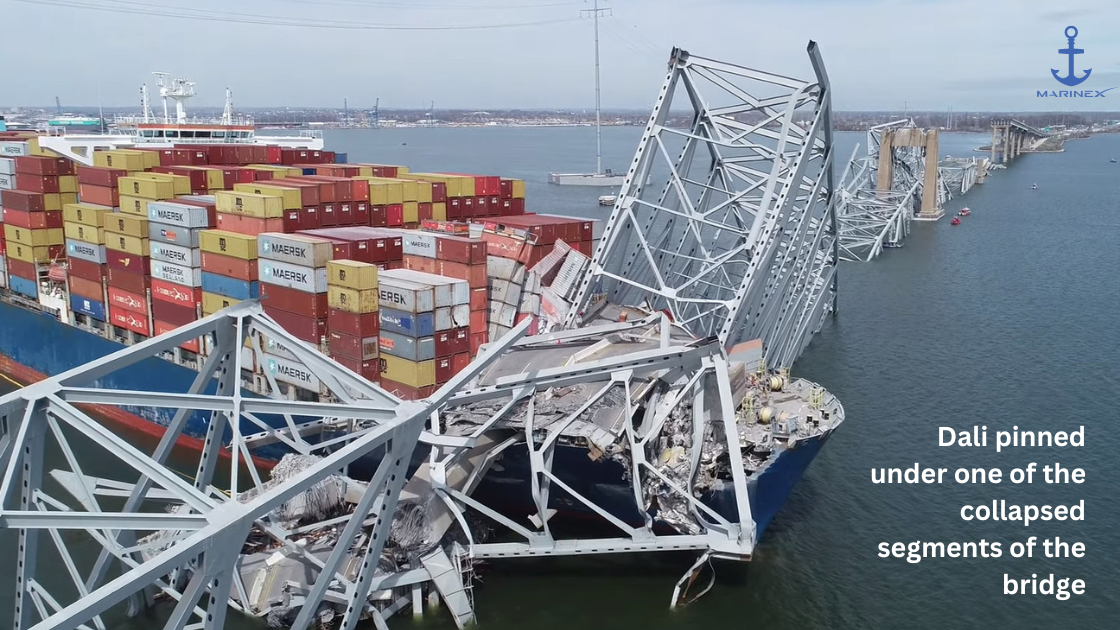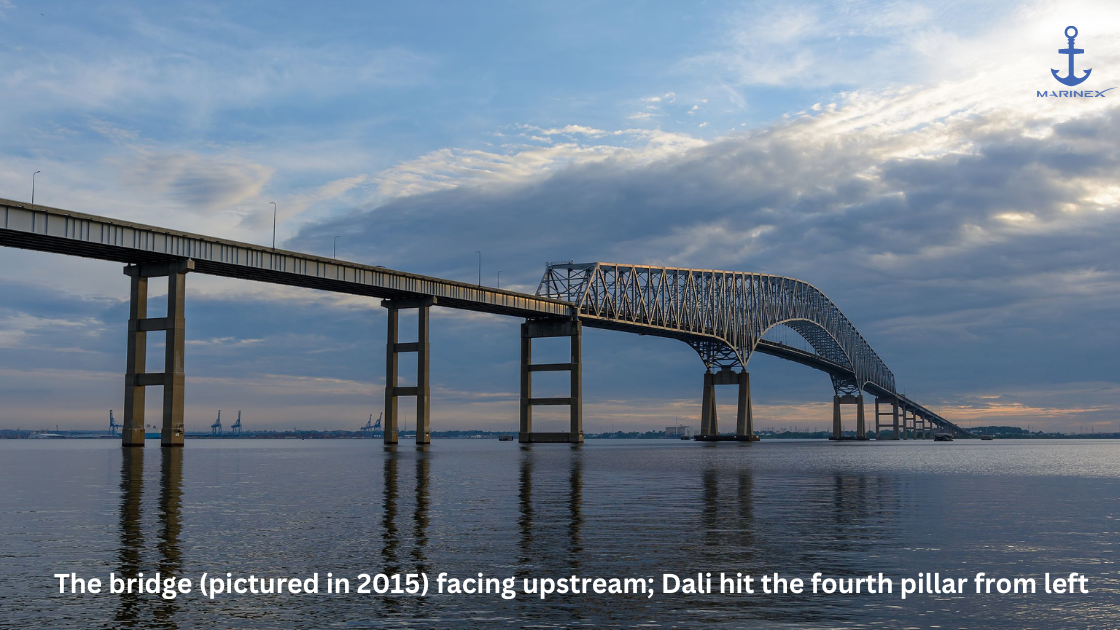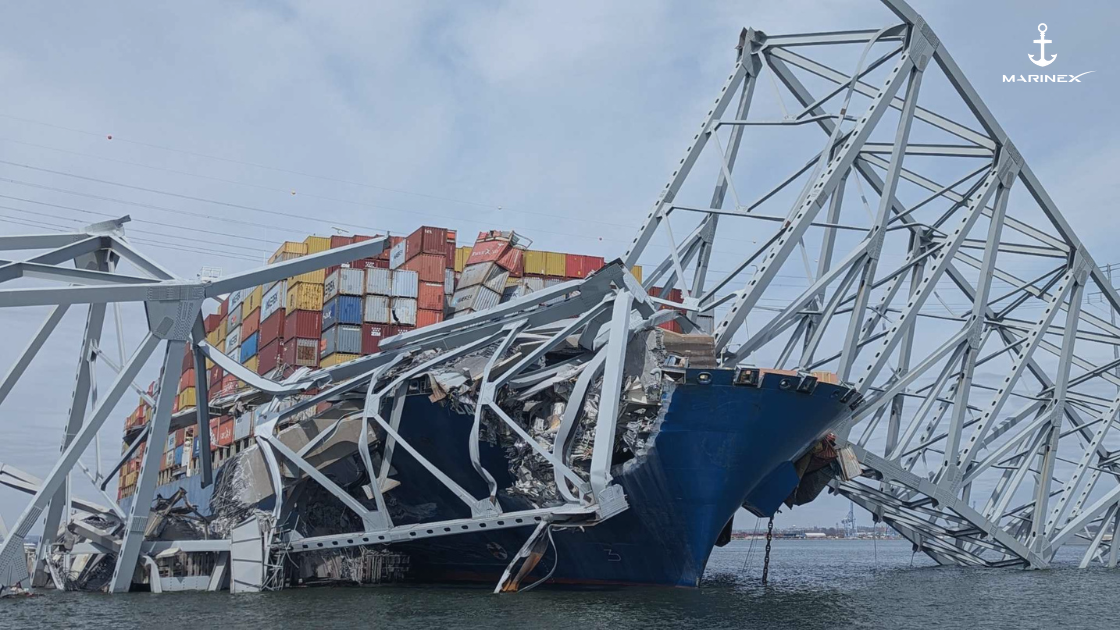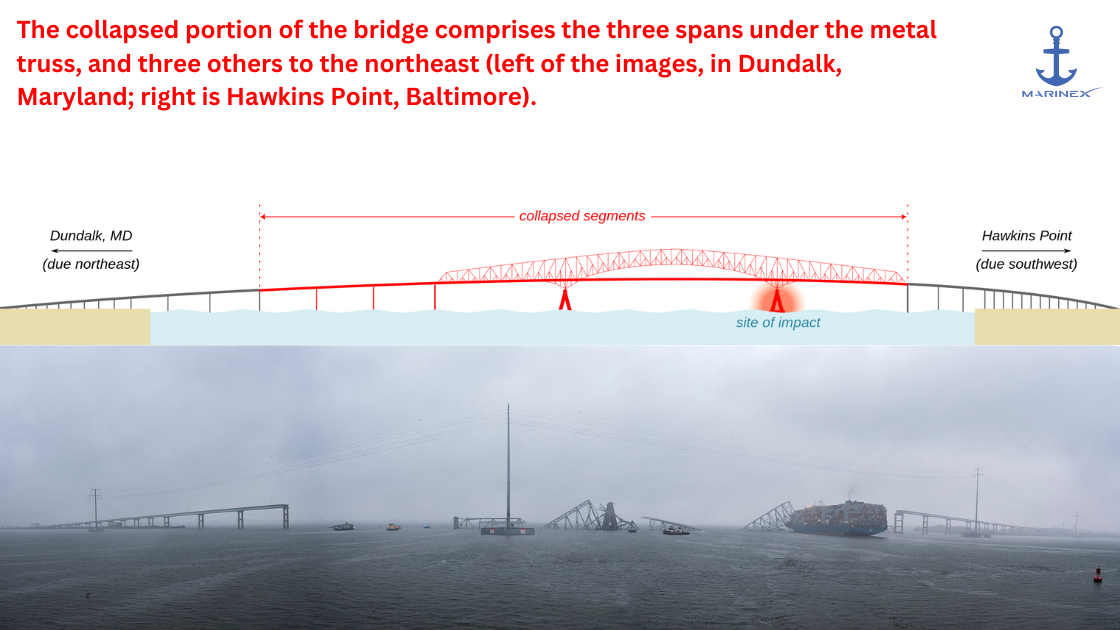Safety at Sea: Unpacking the Baltimore Bridge-MV Dali Incident

From time to time, we hear news about incidents that shake us as maritime professionals. While we cannot turn back time, it is crucial for us, as maritime professionals, to learn, adapt, and move forward to prevent such incidents from recurring. At MarineX, in this blog, we will cover the Baltimore Bridge-MV Dali collision incident in detail.
We hope that as a community, we can all learn from this experience. We also anticipate amendments to regulations globally and within the maritime sector as a consequence of this incident. We will continue to update this blog as the story unfolds.
Needless to say, it is a must-read for all maritime professionals.
The Incident
On March 26, 2024, at 1:28 a.m. EDT (05:28 UTC), the main spans and the three nearest northeast approach spans of the Francis Scott Key Bridge across the Patapsco River near Baltimore, Maryland, collapsed after the container ship Dali struck one of its piers.

Much of the Port of Baltimore remains closed to shipping as a result of the collapse. Wes Moore, the Maryland governor, called the event a "global crisis" and said that more than 8,000 jobs were affected.
The Background
The Francis Scott Key Bridge is a steel arch-shaped continuous truss bridge that opened in 1977. It spans the Patapsco River, connecting Hawkins Point, Baltimore, to Sollers Point in Dundalk. The bridge serves as a vital shipping route providing access to the Port of Baltimore, one of the busiest in the United States.

The bridge, measuring 1.6 miles (2.6 km) in length, carries four lanes of Interstate 695, a beltway around Baltimore, with approximately 34,000 vehicles traversing it daily.
MV Dali, the container ship involved in the collision, is registered in Singapore and operated by Synergy Marine Group. Built in 2015, it measures 980 feet (300 m) in length, with a 157-foot (48 m) beam and a 40-foot (12.2 m) draft. Danish shipping company Maersk chartered Dali upon its delivery.

Before the collision, Dali traveled from Panama to the U.S., arriving in New York on March 19, 2024, then sailed to the Virginia International Gateway in Portsmouth, Virginia, before departing for Baltimore on March 22, arriving the following day.
The main shipping channel under the bridge is estimated to be 50 feet (15 m) deep, while NOAA charts show the depth at the bridge supports to be about 30 feet (9.1 m).
The Collapse

Though Dali's size is considered large, it is smaller than the largest container ship.
However, it's acknowledged that larger ships can lead to more significant disasters, as seen in the case of the 1,300-foot vessel involved in the 2021 Suez Canal obstruction.
Dali departed from the Port of Baltimore at 12:44 a.m. EDT (04:44 UTC) on March 26, 2024, bound for Colombo, Sri Lanka. The ship's crew, consisting of 22 Indian nationals, had two local American harbor pilots on board.
At 1:24 a.m., the ship experienced a "complete blackout" and began drifting out of the shipping channel. Although a backup generator supported electrical systems, it did not provide power to the propulsion system.
At 1:27 a.m., a mayday call was made from the ship, alerting the Maryland Department of Transportation to the loss of control and the possibility of a collision with the bridge, citing the loss of propulsion. One of the pilots requested an immediate stoppage of traffic crossing the bridge.
The ship's lights went out and then came back on moments later, followed by another outage just before impact, accompanied by renewed smoke emission from its funnel. At the pilot's request, the Maryland Transportation Authority Police dispatched officers to stop traffic in both directions.
Outer loop traffic was halted at the south side within 20 seconds, while inner loop traffic was stopped at the north side by 1:28:58 a.m., around the time of the collapse. Singapore's Maritime and Port Authority (MPA) reported that the ship dropped its anchors before hitting the bridge, following emergency procedures.
Within seconds of the collision, the bridge broke apart in several places, leaving sections protruding from the water and cutting off the roadway's approaches. The main span fell onto the ship's bow, with a section coming to rest there. The bridge strike and partial collapse were captured on video.
Several vehicles were on the bridge at the time of the collapse, though initially, it was believed that no one was inside them. Workers repairing potholes on the bridge were in their vehicles on a break at the time of the collapse.
A resident living near the bridge recalled being awakened by deep rumbling that shook his residence for several seconds following the collapse, describing it as feeling like an earthquake.
Emergency teams began receiving 911 calls at 1:30 a.m., with the Baltimore Police Department alerted to the collapse at 1:35 a.m. Large-scale rescue and recovery efforts were initiated, with the United States Coast Guard deploying boats and a helicopter as part of the rescue efforts. Fifty public safety divers in eight teams were dispatched to search for people who fell into the river.
The Damage

The collision of Dali with the southwest main truss pier destroyed it, resulting in the collapse of the entire truss span. As the bridge was a continuous truss bridge, reliant on its overall structure to maintain integrity, it was fracture critical, meaning it had no redundancy against the removal of support of any particular part of it. Therefore, when the south and central spans (on each side of the impacted pier) collapsed, the northern component (the third span) followed.
Thirteen of Dali's 4,700 shipping containers were damaged following the collision, while two containers fell into the water, neither of which carried hazardous substances.
Dali sustained hull damage above the water line and was impaled by remnants of the bridge superstructure, which pressed it against the channel floor.
The ship remained watertight, and the shipping company initially claimed there was no water pollution directly from the ship following the incident. Authorities installed 2,400 feet (730 m) of water containment booms around the ship after a sheen was detected in the waterway, which was believed to have been produced by 21 US gallons (17 imp gal; 79 L) of oil that leaked from a bow thruster on the ship.
On March 27, the National Transportation Safety Board (NTSB) announced an investigation into a hazmat spill resulting from breached containers onboard Dali; some of the 56 containers that carried about 764 tons of hazardous materials, including primarily corrosive and flammable substances as well as lithium batteries, were compromised.
To access the full blog, subscribe to MarineX Premium Plans and elevate your maritime knowledge to the next level. Gain the MarineX Edge for comprehensive insights into all things maritime.
Limited time Super offer on MarineX Plus Membership (50% Forever discount)